Abstract
Three types of Staphylococcus aureus strains were isolated with respect to streptomycin (SM) and spectinomycin (SPC) resistance, namely, SMrSPCr, SMrSPCs, and SMsSPCr (r, resistant; s, sensitive). Curing experiments and transduction analysis of strain MS7990 (SMr.SPCr.EMr) (EM, erythromycin) disclosed that the loci governing SM and SPC resistance are different and exist on different nontransferable plasmids (r factor), one plasmid carrying the genes governing SM resistance and another possessing the genes governing resistance to both SPC and EM. Strain MS7990 (SMr.SPCr) inactivated both drugs by adenylylation. Similarly, the SMrSPCs and SMsSPCr strains inactivated SM and SPC, respectively, by adenylylation, although the adenylylated positions of both drugs have not been established as yet. The adenylylated SM in staphylococci was shown to be different from 3″-adenylyl-SM, indicating the possibility of the existence of a different enzyme from SM3″-adenylyl transferase demonstrated in Escherichia coli strains.
Full text
PDF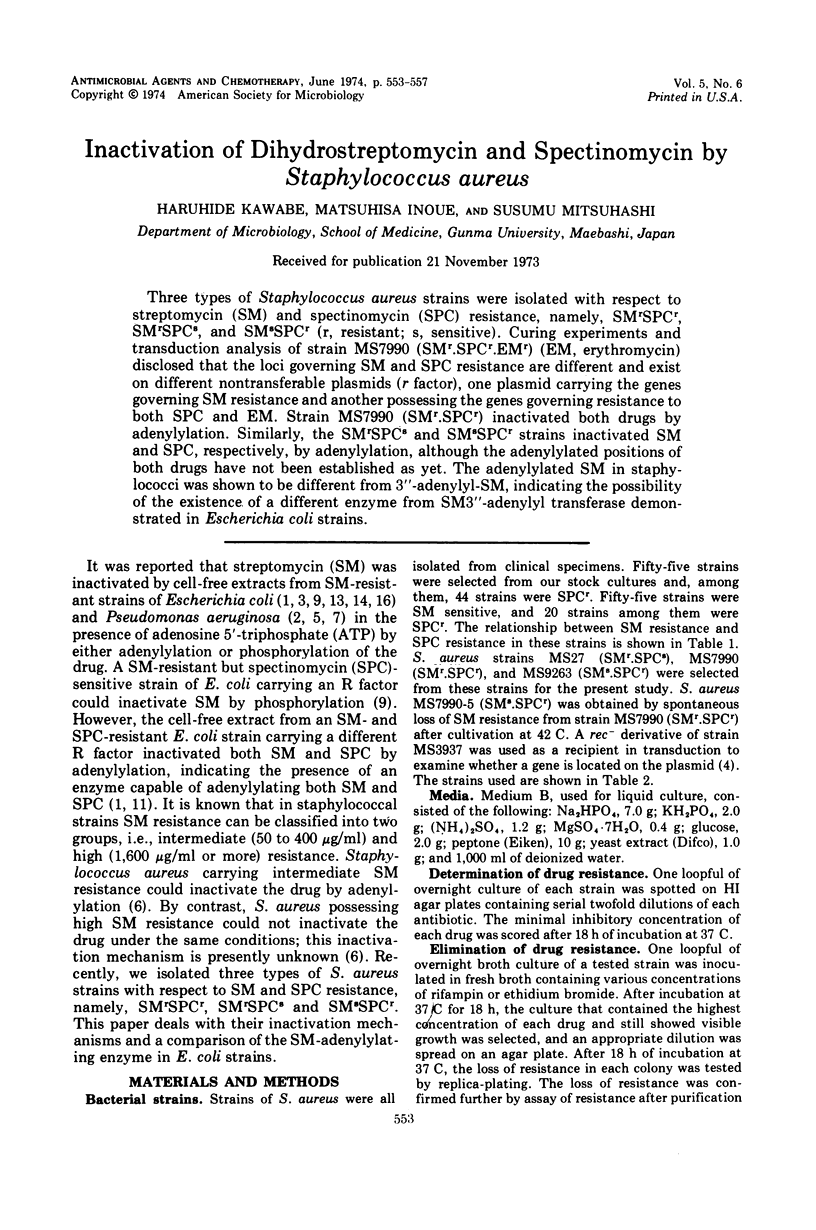
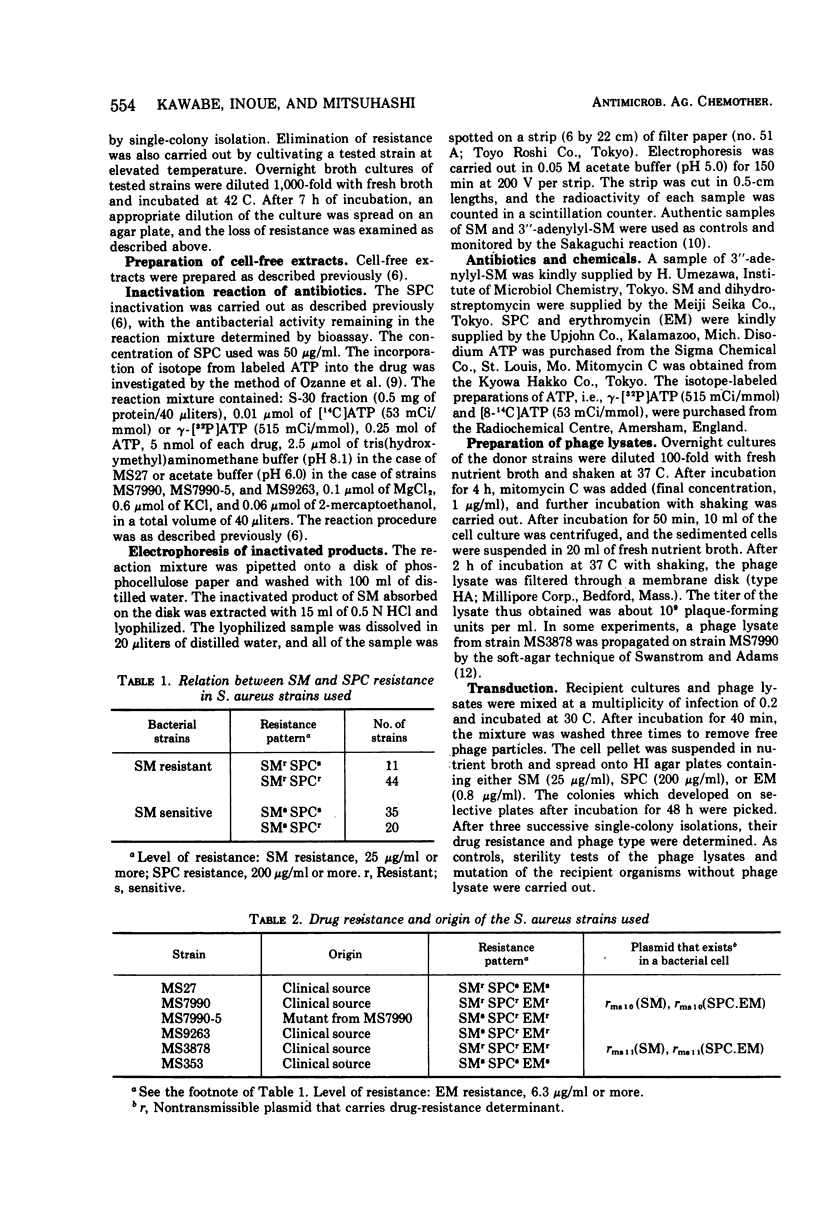
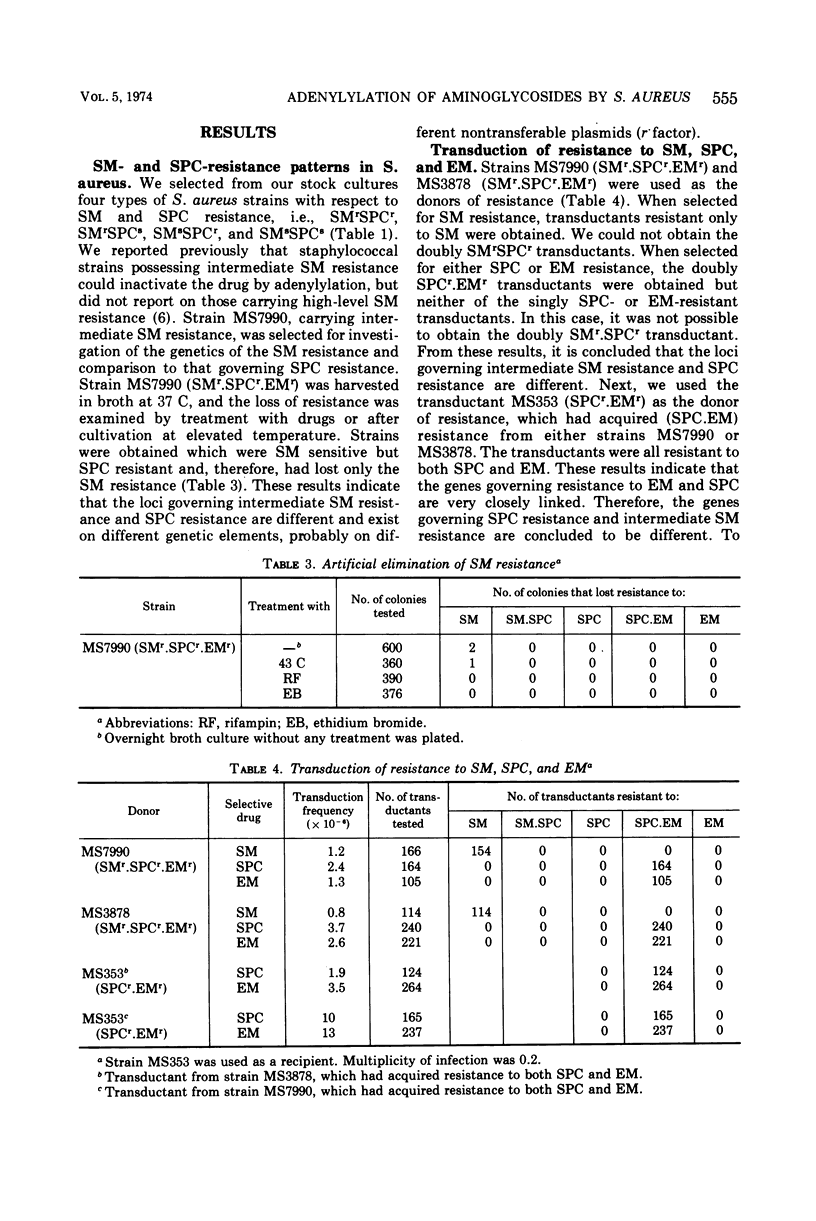
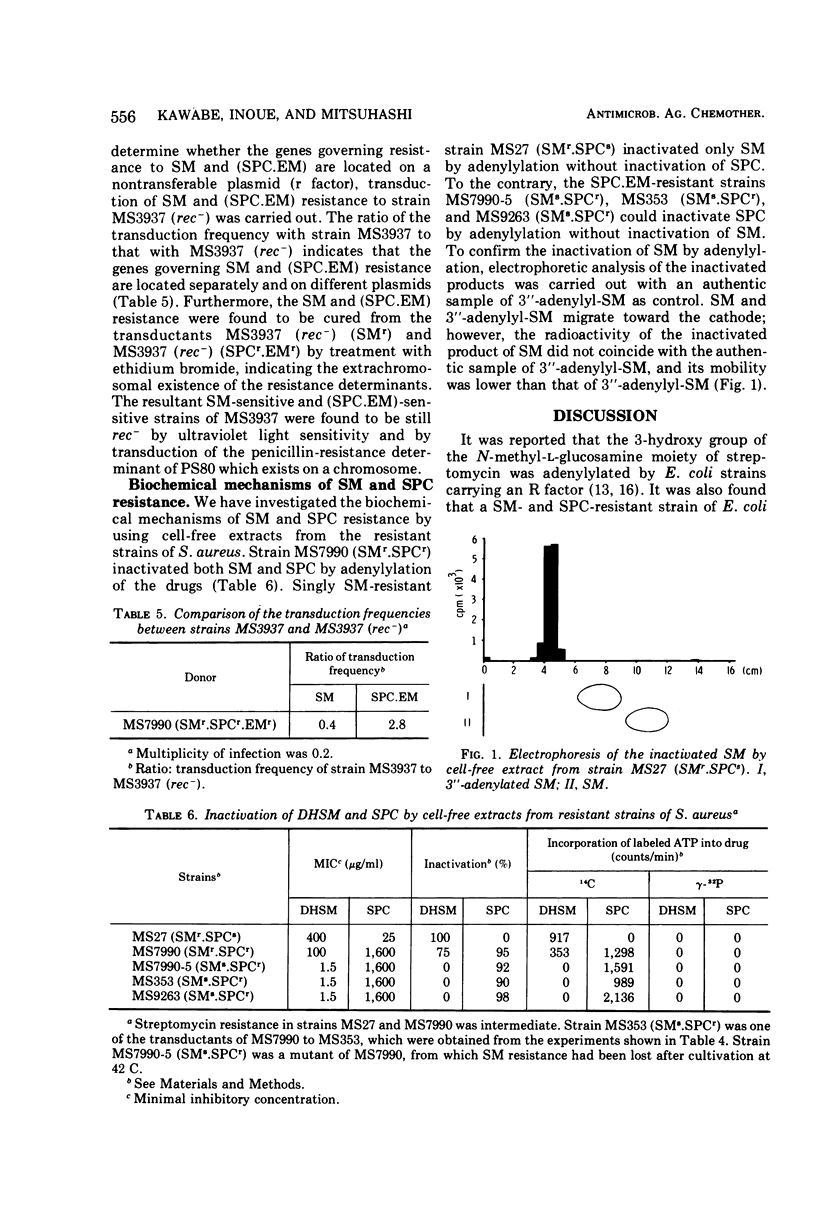
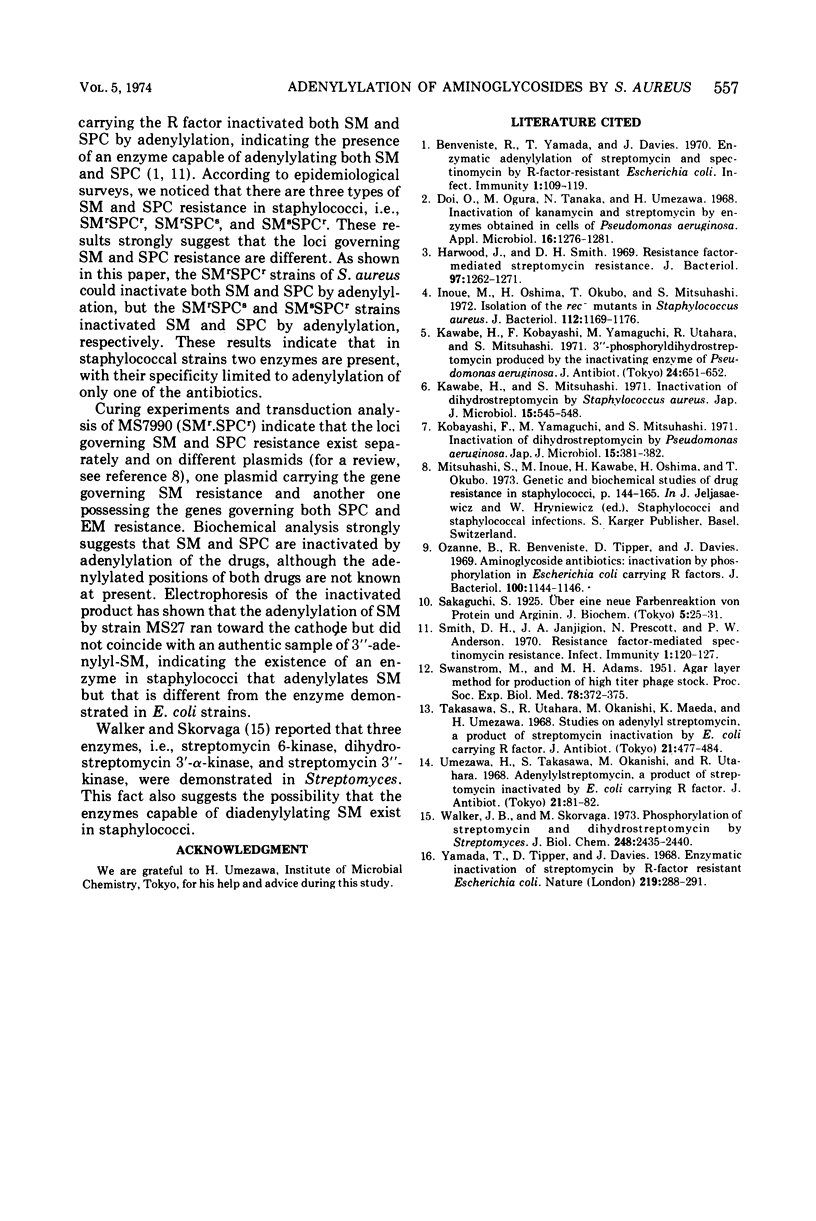
Selected References
These references are in PubMed. This may not be the complete list of references from this article.
- Benveniste R., Yamada T., Davies J. Enzymatic Adenylylation of Streptomycin and Spectinomycin by R-Factor-Resistant Escherichia coli. Infect Immun. 1970 Jan;1(1):109–119. doi: 10.1128/iai.1.1.109-119.1970. [DOI] [PMC free article] [PubMed] [Google Scholar]
- Doi O., Ogura M., Tanaka N., Umezawa H. Inactivation of kanamycin, neomycin, and streptomycin by enzymes obtained in cells of Pseudomonas aeruginoa. Appl Microbiol. 1968 Sep;16(9):1276–1281. doi: 10.1128/am.16.9.1276-1281.1968. [DOI] [PMC free article] [PubMed] [Google Scholar]
- Harwood J. H., Smith D. H. Resistance factor-mediated streptomycin resistance. J Bacteriol. 1969 Mar;97(3):1262–1271. doi: 10.1128/jb.97.3.1262-1271.1969. [DOI] [PMC free article] [PubMed] [Google Scholar]
- Inoue M., Oshima H., Okubo T., Mitsuhashi S. Isolation of the rec mutants in Staphylococcus aureus. J Bacteriol. 1972 Dec;112(3):1169–1176. doi: 10.1128/jb.112.3.1169-1176.1972. [DOI] [PMC free article] [PubMed] [Google Scholar]
- Kawabe H., Kobayashi F., Yamaguchi M., Utahara R., Mitsuhashi S. 3"-phosphoryldihydrostreptomycin produced by the inactivating enzyme of Pseudomonas aeruginosa. J Antibiot (Tokyo) 1971 Sep;24(9):651–652. doi: 10.7164/antibiotics.24.651. [DOI] [PubMed] [Google Scholar]
- Kawabe H., Mitsuhashi S. Inactivation of dihydrostreptomycin by Staphylococcus aureus. Jpn J Microbiol. 1971 Nov;15(6):545–548. doi: 10.1111/j.1348-0421.1971.tb00618.x. [DOI] [PubMed] [Google Scholar]
- Kobayashi F., Yamaguchi M., Mitsuhashi S. Inactivation of dihydrostreptomycin by Pseudomonas aeruginosa. Jpn J Microbiol. 1971 Jul;15(4):381–382. doi: 10.1111/j.1348-0421.1971.tb00596.x. [DOI] [PubMed] [Google Scholar]
- Mitsuhashi S., Inoue M., Kawabe H., Oshima H., Okubo T. Genetic and biochemical studies of drug resistance in staphylococci. Contrib Microbiol Immunol. 1973;1:144–165. [PubMed] [Google Scholar]
- Ozanne B., Benveniste R., Tipper D., Davies J. Aminoglycoside antibiotics: inactivation by phosphorylation in Escherichia coli carrying R factors. J Bacteriol. 1969 Nov;100(2):1144–1146. doi: 10.1128/jb.100.2.1144-1146.1969. [DOI] [PMC free article] [PubMed] [Google Scholar]
- SWANSTROM M., ADAMS M. H. Agar layer method for production of high titer phage stocks. Proc Soc Exp Biol Med. 1951 Nov;78(2):372–375. doi: 10.3181/00379727-78-19076. [DOI] [PubMed] [Google Scholar]
- Smith D. H., Janjigian J. A., Prescott N., Anderson P. W. Resistance factor-mediated spectinomycin resistance. Infect Immun. 1970 Jan;1(1):120–127. doi: 10.1128/iai.1.1.120-127.1970. [DOI] [PMC free article] [PubMed] [Google Scholar]
- Takasawa S., Utahara R., Okanishi M., Maeda K., Umezawa H. Studies on adenylylstreptomycin, a product of streptomycin inactivation by E. coli carrying the R-factor. J Antibiot (Tokyo) 1968 Aug;21(8):477–484. doi: 10.7164/antibiotics.21.477. [DOI] [PubMed] [Google Scholar]
- Umezawa H., Takasawa S., Okanishi M., Utahara R. Adenylylstreptomycin, a product of streptomycin inactivated by E. coli carrying R factor. J Antibiot (Tokyo) 1968 Jan;21(1):81–82. doi: 10.7164/antibiotics.21.81. [DOI] [PubMed] [Google Scholar]
- Walker J. B., Skorvaga M. Phosphorylation of streptomycin and dihydrostreptomycin by Streptomyces. Enzymatic synthesis of different diphosphorylated derivatives. J Biol Chem. 1973 Apr 10;248(7):2435–2440. [PubMed] [Google Scholar]
- Yamada T., Tipper D., Davies J. Enzymatic inactivation of streptomycin by R factor-resistant Escherichia coli. Nature. 1968 Jul 20;219(5151):288–291. doi: 10.1038/219288a0. [DOI] [PubMed] [Google Scholar]


